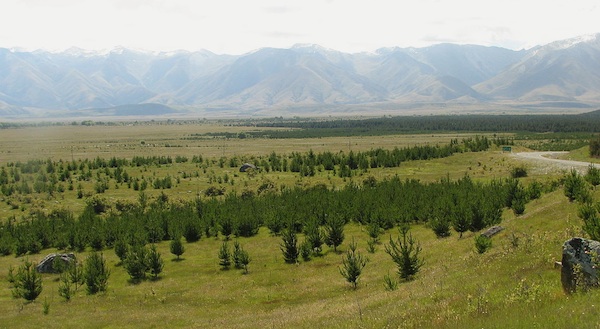The high heat and low water conditions produced by global warming weaken pine trees’ resistance to disease by hindering their ability to mount an effective defense at the same time that pathogenic fungi in their tissues become more aggressive, new research suggests.
The study is the first to simultaneously examine metabolic gene expression in both host trees and the pathogens attacking them under normal and climate-change conditions. The findings help explain the mechanisms behind what has become a well-known fact: The warming world makes trees more susceptible to disease.
The study was conducted on Austrian pines, which are native to southern Europe and used ornamentally in the United States. Researchers tested climate change conditions’ effects on the trees after infection by two related fungi that have killed large swaths of these pines over time.
“We decided to study the effects of the combined stresses of higher temperatures and lower water availability because that’s what trees will experience in the future,” said senior author Enrico Bonello, professor of molecular and chemical ecology of trees in The Ohio State University Department of Plant Pathology.
“Within three days of infection under climate-change conditions, the tree was pulled in two different directions: It was deprived of carbon by both reduced photosynthesis and enhanced acquisition of the carbon by the fungi. When we’re talking about carbon, we’re talking about sugars, food and reserves for all other metabolic processes in the trees, including growth and defense.”
The research was published recently in the journal Frontiers in Forests and Global Change.
Carbon sequestration by the world’s forests is a major mitigator of climate change’s effects, and could be accelerated if improvements are made to their protection, management and restoration, experts say. In a 2021 study of U.S. forest plots, scientists estimated recent disease and insect disturbances had lowered carbon sequestration rates by 28% and 69%, respectively, from 2001-2019 compared to undisturbed forests.
“This is another reason to combat global warming induced by human activities — another piece of evidence that what we are doing to the planet has so many implications,” Bonello said.
He and colleagues exposed 3-year-old Austrian pines to two sets of conditions: daily temperatures ranging from 59 to 82.4 degrees Fahrenheit for the control or, to mimic climate change conditions, daily temperatures of 68 to 91.4 degrees Fahrenheit, which reduced the amount of water in the atmosphere compared to available water in the cooler temperatures. After trees got accustomed to their conditions, they were inoculated with one of two strains of the pathogenic fungus.
Diplodia sapinea, an aggressive fungus, and its less-aggressive relative Diplodia scrobiculata are found in both the Northern and Southern hemispheres. They remain dormant much of the time, waiting for the best opportunity to kill host cells and feed on the dead plant material — usually when their host is weakened. In addition to killing Austrian pines, the fungi have also begun damaging Scots pines in Scandinavia.
“The hypothesis is that the warming and lower water availability in those areas is making trees more susceptible to a pathogen that would normally sit in the background,” Bonello said.
Three days after infection, the team collected plant and pathogen tissue that was used for an RNA sequencing analysis to identify gene activation, or expression, pattern changes in the trees and both strains of the fungi.
The analysis showed a fundamental change in the trees exposed to the climate-change conditions: Their capacity to carry out photosynthesis decreased, meaning they had fewer resources to invest in their own food supply, growth and defense against disease. At the same time, both strains of the fungus ramped up their carbon utilization machinery, and the usual difference between their aggressiveness disappeared — they became significantly more pathogenic, and to the same extent, than under normal conditions.
“Essentially, climate change conditions led the host to starvation, which is compounded by the fact that the fungi became more aggressive, grew faster and killed more host tissue faster,” Bonello said. “These were early responses, but it gives us an idea of what’s happening in the system.”
While these results are one example of one tree species and one type of pathogen, the research offers insights into how much damage global warming may do to one of the planet’s main carbon sinks.
“Pathogen and pest invasions are already having an effect on carbon sequestration,” Bonello said. “If you make it even worse with climate change, carbon sequestration will be affected negatively because trees will die in ever larger numbers. Trees that might otherwise survive adverse environmental conditions for a while, and recover if conditions become better or intermittent, may be killed by pathogens in the meantime.”
This work was supported by the Ohio Agricultural Research and Development Center, Ohio State’s College of Food, Agricultural and Environmental Sciences, the U.S. Department of Agriculture Forest Service and the National Science Foundation.
Bonello and Ohio State co-authors Soumya Ghosh, Jason Slot, Michael Sovic, Anna Conrad, Bethany Kyre and Vinod Vijayakumar collaborated on the study with Erik Visser and Sanushka Naidoo of the University of Pretoria in South Africa.
Journal Reference:
- Soumya K. Ghosh, Jason C. Slot, Erik A. Visser, Sanushka Naidoo, Michael G. Sovic, Anna O. Conrad, Bethany Kyre, Vinod Vijayakumar, Pierluigi Bonello. Mechanisms of Pine Disease Susceptibility Under Experimental Climate Change. Frontiers in Forests and Global Change, 2022; 5 DOI: 10.3389/ffgc.2022.872584
Source: ScienceDaily












